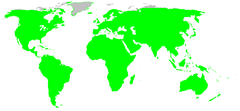Theridiidae
| Tangle web spiders Temporal range: Cretaceous - present |
|
|---|---|
 |
|
| Enoplognatha ovata | |
| Scientific classification | |
| Kingdom: | Animalia |
| Phylum: | Arthropoda |
| Subphylum: | Chelicerata |
| Class: | Arachnida |
| Order: | Araneae |
| Infraorder: | Araneomorphae |
| Family: |
Theridiidae Sundevall, 1833 |
| Genera | |
|
See text. |
|
| Diversity | |
| 109 genera, 2295 species | |
 |
|
See text.
Theridiidae is a large family of spiders, also known as the tangle-web spiders, cobweb spiders and comb-footed spiders. The diverse family includes over 2200 species in over 100 genera of three-dimensional space-web-builders found throughout the world. Theridiid spiders are entelegyne (have a genital plate in the female) araneomorph ecribellate (use sticky capture silk instead of woolly silk) spiders that often build tangle space webs and have a comb of serrated bristles (setae) on the tarsus of the fourth leg.
The family includes some model organisms for research, for example, the genus Latrodectus, the medically important widow spiders. In addition to studies characterizing their venom and its clinical manifestation, widow spiders are broadly used in research on spider silk, and on sexual biology including sexual cannibalism.
Anelosimus spiders are also model organisms, used for the study of sociality, its evolution, and its ecological and evolutionary causes and consequences. They are particularly important for such studies as the genus contains species varying from solitary to permanently social, and because sociality has evolved frequently within the genus allowing comparative studies across species. These spiders are also a promising model for the study of inbreeding as their mating system co-varies with sociality, and all permanently social species are highly inbred.
One species in Theridion, the Hawaiian T. grallator, is used as a model to understand the selective forces and the genetic basis of color polymorphism within species. Theridion grallator is known as the "happyface" spider, as certain morphs have a pattern uncannily resembling a smiley face or a grinning clown face on their yellow body.
...
Wikipedia
